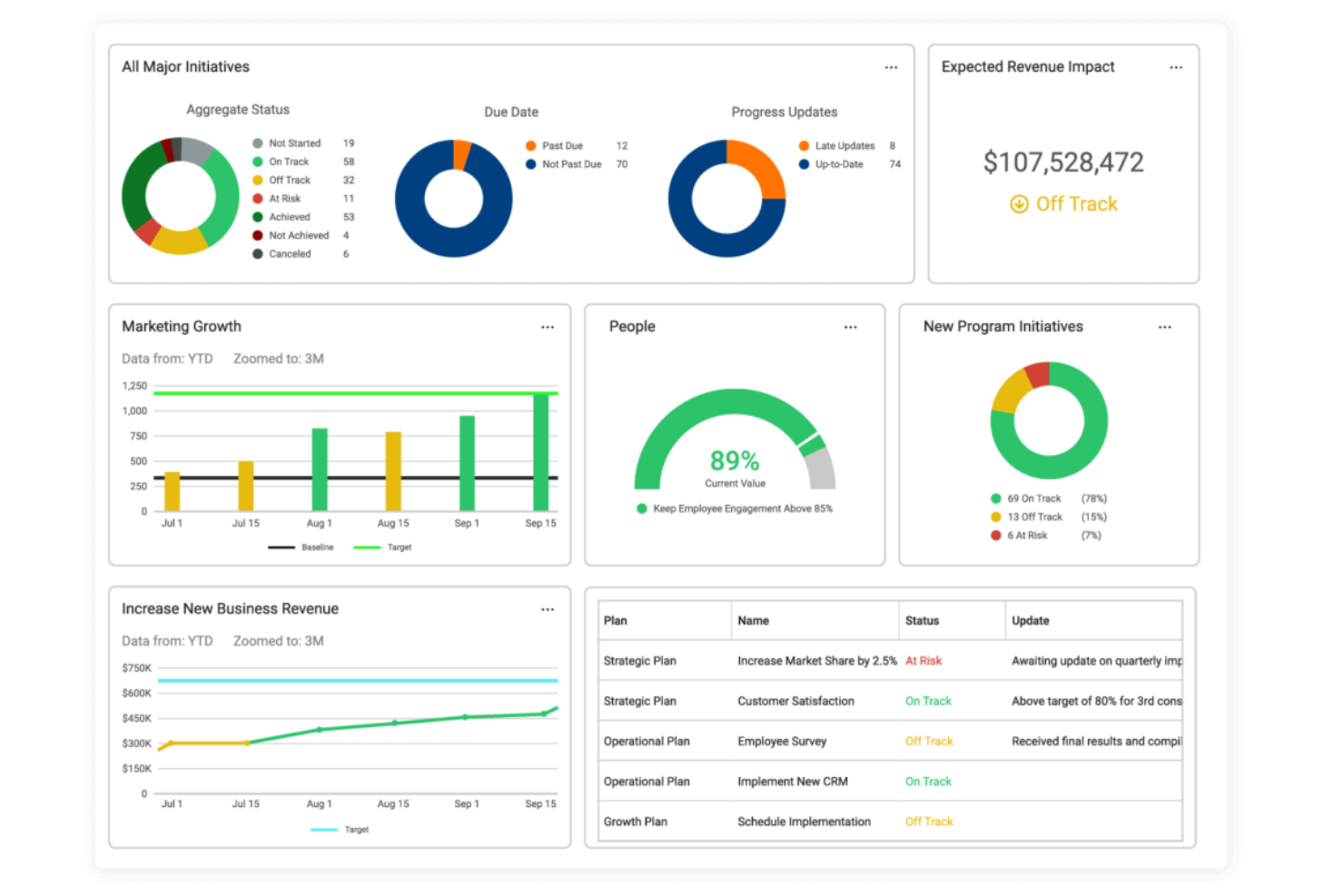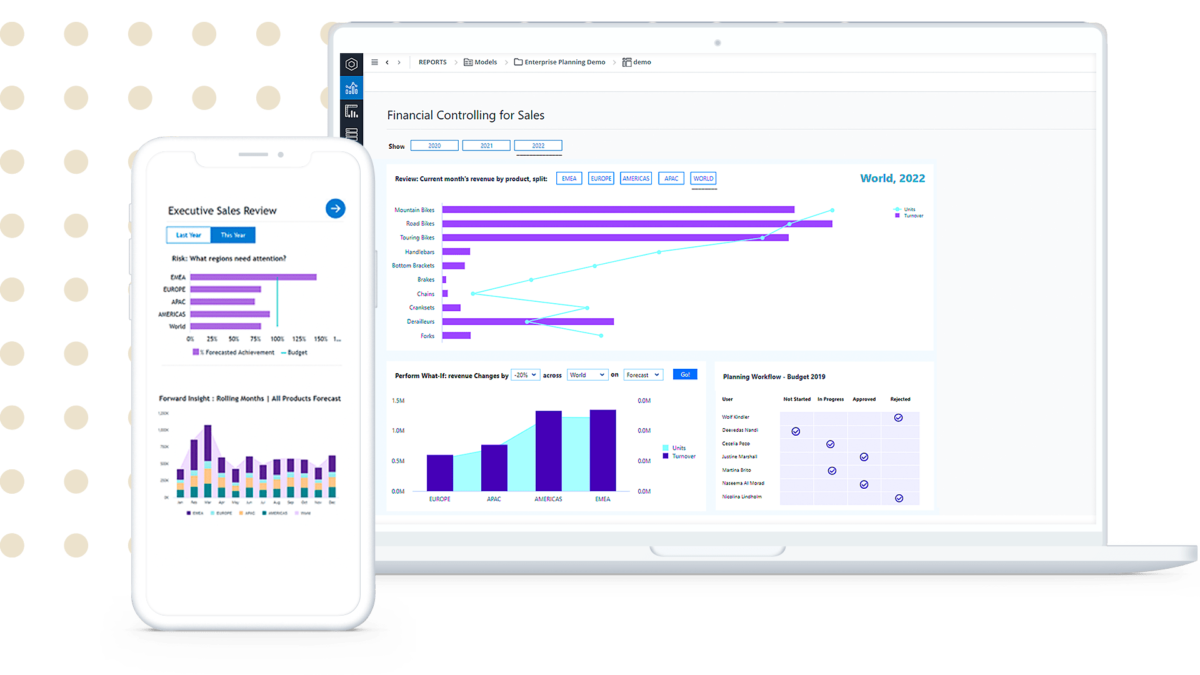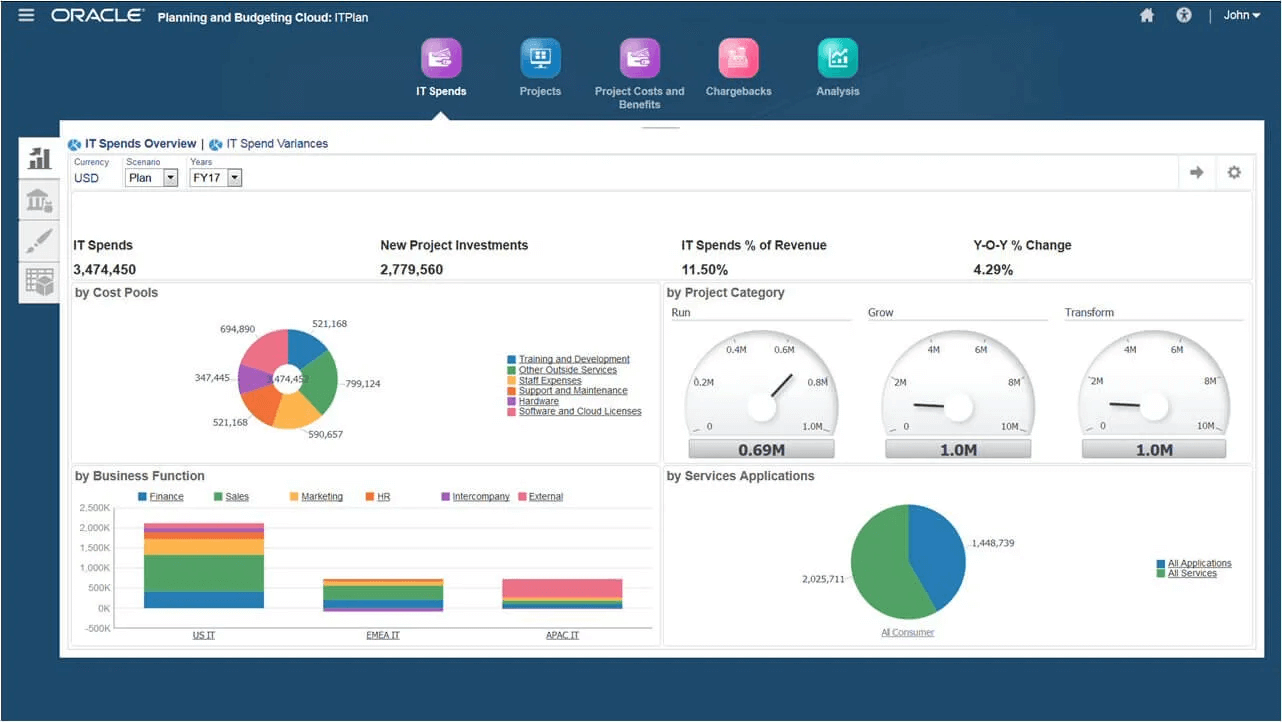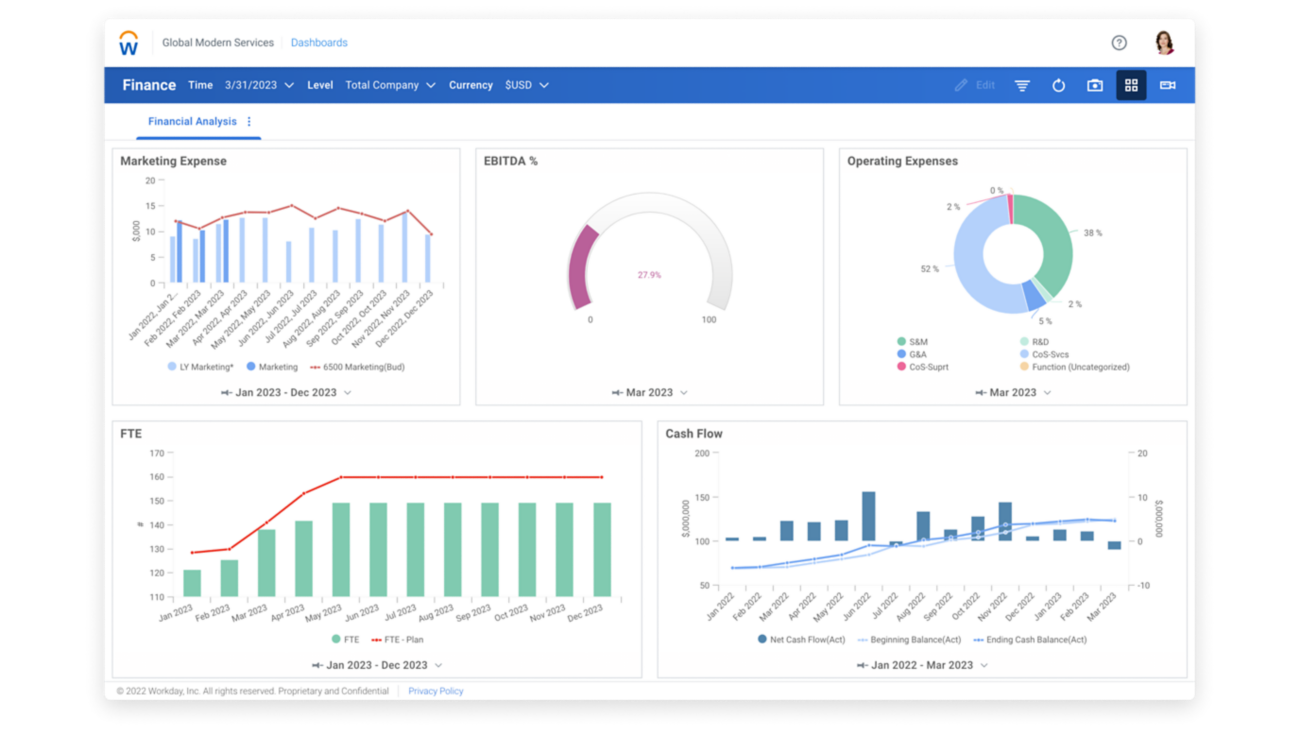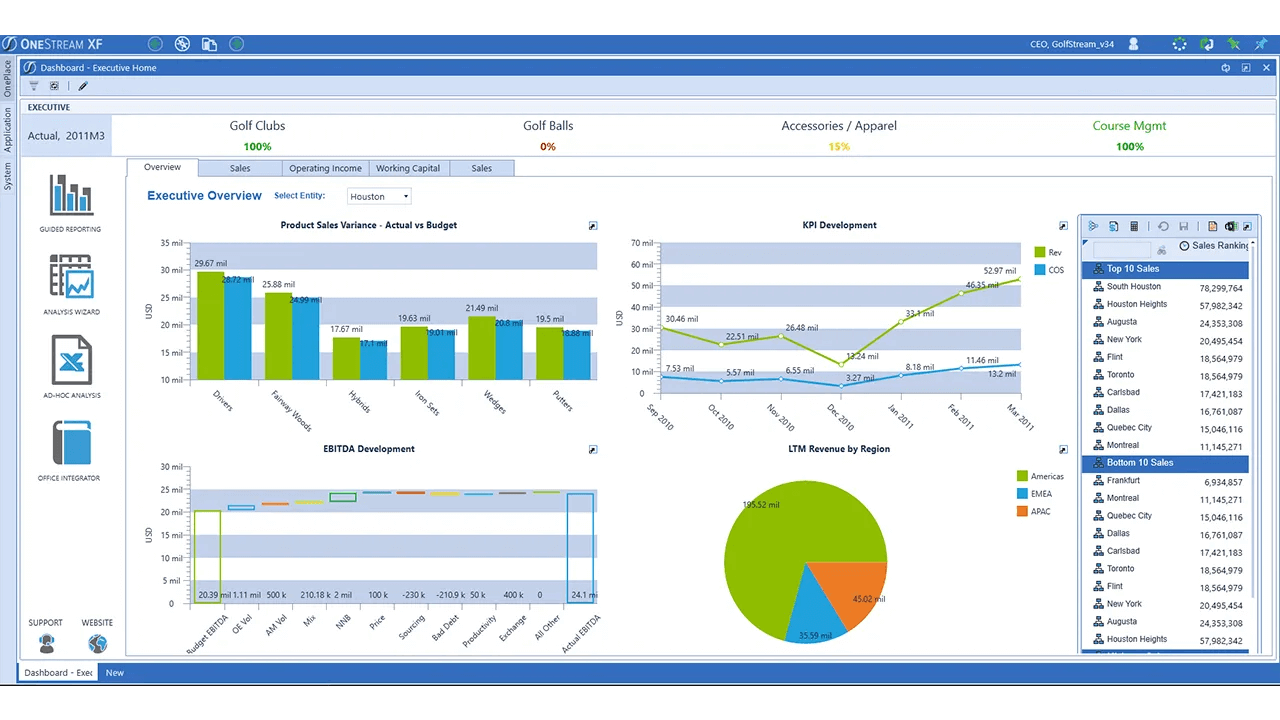10 Best EPM Software Providers Shortlist
Here's my pick of the 10 best software from the 20 tools reviewed.
Our one-on-one guidance will help you find the perfect fit.
With so many different enterprise performance management solutions available, figuring out which one is right for you is tough. You know you want to have a unified platform for budgeting, forecasting, financial consolidation, and strategic planning, but need to figure out which tool is best for the job. I've got you! In this post I'll help make your choice easy, being exposed to a variety of EPM tools in my consulting days, I lean on that experience and my first-hand research as I review this curated list of the best EPM software.
| Tool | Best For | Trial Info | Price | ||
|---|---|---|---|---|---|
| 1 | Best for agency profitability tracking | 14-day free trial | From $9/month (billed annually) | Website | |
| 2 | Best for connecting all business units | Free demo available | Pricing upon request | Website | |
| 3 | Best for goal and objective tracking | Free demo available | From $70/user/month | Website | |
| 4 | Best for demand forecasting and long-range planning | Free demo available | Pricing upon request | Website | |
| 5 | Best for mobile | Free demo available | Pricing upon request | Website | |
| 6 | Best for financial close management | Free demo available. | Pricing upon request | Website | |
| 7 | Best for advanced scenario analysis | Free trial available | Pricing upon request | Website | |
| 8 | Best for manufacturing firms | Free demo available | Price upon request | Website | |
| 9 | Best for custom software solutions | Free demo available | Pricing upon request | Website | |
| 10 | Best for retailers and e-commerce | Free demo available | Pricing upon request | Website |
-

LiveFlow
Visit WebsiteThis is an aggregated rating for this tool including ratings from Crozdesk users and ratings from other sites.4.9 -

Float Financial
Visit Website -

Vena
Visit WebsiteThis is an aggregated rating for this tool including ratings from Crozdesk users and ratings from other sites.4.5
Overview Of The Best EPM Software For 2025
Based on the selection criteria outlined in this guide, here’s my list of the best EPM software solutions on the market.
Productive is an all-encompassing agency management platform designed to enhance the efficiency and productivity of agencies of all sizes. The software offers a suite of tools that streamline operations, from project management and resource planning to budgeting and invoicing.
Why I Picked Productive: Productive is particularly well-suited for enterprise performance management due to its comprehensive project management capabilities. Enterprises can benefit from advanced features such as Gantt charts, task boards, and project timelines. Additionally, the platform's robust budgeting and financial forecasting tools enable enterprises to manage project costs, predict revenue, and maintain financial health.
Productive's ability to provide real-time insights into team performance and project profitability also makes it an invaluable tool for large agencies looking to optimize their operations. Enterprises can even generate custom reports that provide deep insights into various aspects of their operations, from team utilization and project performance to financial metrics.
Productive Standout Features and Integrations
Features include time tracking, Gantt charts, Sales CRM, workload management, purchase orders, automation, AI integration, custom permission settings, detailed reporting, invoicing, revenue recognition, and resource planning.
Integrations include Jira, Slack, QuickBooks, Xero, Google Calendar, Zapier, Sage, BambooHR, Rippling, and HubSpot.
Pros and cons
Pros:
- Resource management features help with optimizing utilization
- Good financial management module
- Robust reporting capabilities
Cons:
- Initial setup can take time
- Could use more integrations
Phocas is a comprehensive platform that offers a range of analytics and business solutions for various industries. The software provides tools for financial statements, budgets, forecasts, strategic planning, and data modeling.
Why I picked Phocas: I picked Phocas because it consolidates your data in one place and provides customizable reports for financials, performance, budgets, and other metrics across all your business units. It also has a robust forecasting capability that allows you to scenario plan, create goals, and compare real-time actual stats with planned performance across teams, products, and even regions.
I also like the Phocas AI feature which helps those with limited technical expertise with finding the data they need to make informed decisions. Phocas AI lets you ask questions and it will provide insights, whether it's about customers, sales, products, or financials.
Phocas Standout Features and Integrations:
Standout features include CRM functionalities, customizable dashboards, rebate management, collaborative workflows, an ad-hoc analysis layer, privacy compliance, and security controls.
Integrations include Sage, SAP, Sympac, Netsuite, Oracle, QAD, Retail Express, Epicor, IFS, Jonas Metals Software, Acumatica, Xero, Accolent, Datafile, MYOB, Enapps, Kerridge, Khaos Control, MAM Software, Merlin, Microsoft, SYSPRO, and more.
Pros and cons
Pros:
- Phocas AI for better accessibility
- Robust data modeling capabilities
- Consolidated, real-time analytics
Cons:
- May take time to learn how to maximize its features
- Overwhelming amount of data
AchieveIt is a strategic planning software that assists businesses in managing and assessing progress updates and data across various plans and initiatives.
Why I picked AchieveIt: I like its goal and objective tracking system, which allows organizations to set, monitor, and achieve their strategic targets with precision. By providing a centralized platform for aligning goals across departments and teams, AchieveIt ensures that everyone is working towards the same objectives, fostering a more cohesive and focused approach to performance management.
The software also generates detailed reports that offer insights into key performance indicators (KPIs), allowing organizations to continuously assess their progress and make necessary adjustments. These reports are not only automated but also customizable, providing the flexibility to meet the specific needs of different stakeholders.
AchieveIt Standout Features and Integrations:
Standout features include tree, list, and Gantt charts for plan creation and automation for collecting updates, compiling reports, and creating dashboards. It also offers real-time data dashboards, customizable project templates, automated task reminders, and risk management tools.
Integrations include Microsoft Excel, Microsoft Power BI, Salesforce, Tableau, Google Analytics, Slack, Microsoft Teams, Jira, Trello, Asana, SharePoint, OneDrive, and Dropbox.
Pros and cons
Pros:
- Real-time updates
- Various ways to visualize data
- Automated reporting capabilities
Cons:
- May not fully integrate with some existing systems and tools
- Interface can be confusing for some users
Anaplan is an industry-leading EPM software that has applications for finance, sales and marketing, supply chain management, and HR. The advanced platform is used by thousands of large enterprises, including Coca-Cola and Amazon Web Services—but it’s versatile enough for companies of all shapes and sizes.
Why I picked Anaplan: I selected Anaplan because of its supply chain management tools and advanced forecasting features. It has solid applications enterprise-wide, but it’s particularly useful for supply chain and procurement.
In the age of supply chain disruptions, Anaplan’s inventory management features really stand out. Anaplan can help you predict future demand with more accuracy, so you have time to ramp up, or slow down, production accordingly.
Anaplan Standout Features and Integrations:
Standout features of Anaplan include its scenario planning and demand forecasting capabilities. It can give you predictive warnings for low-stock levels, inventory shortages, excess inventory alerts, and other information to help manage your supply chain.
Anaplan makes data more accessible, so business leaders can model complex “what if” scenarios to help firms identify the most profitable price point for a product or the ideal reorder point for different inventory items.
Integrations include cloud data platforms from AWS, Microsoft Azure, and Google BigQuery.
Pros and cons
Pros:
- Personalized demos available with customized setup
- Departmental solutions across finance, marketing, and HR
- Advanced supply chain management features
Cons:
- Additional fee for most features and add-ons
- Steep learning curve
Jedox focuses on financial and operational insights to help firms accelerate planning, and all of its features are accessible through the mobile app (both iOS and Android).
Why I picked Jedox: I selected Jedox for several reasons, but the main differentiator is that it has a great mobile app on both iOS and Android. While mobile functionality is slightly different from the desktop version, users will still appreciate mobile support.
It utilizes machine learning and AI to help automate certain financial processes and provide predictive analytics to managers. It’s fairly finance-focused but also has some use cases in marketing, HR, and sales.
Jedox Standout Features and Integrations:
Standout features of Jedox include simple deployment for an easy and low-cost setup, a great mobile app, multidimensional data analysis, and machine learning predictive tech. There’s an impressive library of pre-built forecasting models, and Jedox gives you custom modeling abilities as well.
Jedox’s streamlined collaboration features get teams on the same page. Data can be integrated from any source and stored in a central hub that everyone on your team can access.
Integrations include Jedox Marketplace apps for financial consolidation, sales and operations planning, and HR, plus self-service integration with third-party apps.
Pros and cons
Pros:
- Simple customizations and self-service integration
- Solid mobile app
- No-code customization
Cons:
- Slow support response time
- Intermittent performance issues and downtime
Where the software shines brightest is in finance: Oracle is known as a leading platform for financial close solutions. Automatic cash flow and balance sheet calculations, intelligent process automation, and built-in reporting standards are just a few of the standout features for finance departments.
Why I picked Oracle EPM Cloud: I picked Oracle Cloud EPM primarily because of its financial close features, global reporting standards functionality, and multi-currency support. This platform also excels for multinational firms. Multi-currency support and global reporting standard compliance tools help large organizations manage global operations more efficiently.
Oracle EPM Cloud Standout Features and Integrations
Standout features of Oracle EPM Cloud include personalized recommendations from comprehensive AI, built-in global reporting and compliance standards and multi-currency support for international firms, and tools for efficient financial closing.
Oracle EPM Cloud helps organizations manage, plan for, and model scenarios for specific departments, regions, or market segments. It’s still easy to drill down on a local or product-line level, making Oracle Cloud EPM a versatile tool.
Integrations include Microsoft Excel, Word, PowerPoint, and native apps for reconciliation, tax reporting, and financial consolidation.
Pros and cons
Pros:
- Pre-built departmental solutions with the ability to customize
- Direct integration with MS Excel
- Streamlined financial closing and account reconciliation
Cons:
- Difficult UI for new users
- Data retrieval can be slow
Workday Adaptive Planning is part of the Workday software suite, a set of tools used by the likes of Microsoft, Airbnb, and HubSpot. “Adaptive Planning” is a well-suited name, as Workday users can collaborate across multiple platforms (web, mobile, Excel) to plan and budget with confidence.
Why I picked Workday Adaptive Planning: I selected Workday because it has some of the most advanced scenario analysis tools to help firms plan for contingencies and new strategy implementations.
Workday Adaptive Planning Standout Features and Integrations:
Standout features of Workday Adaptive Planning include work-anywhere deployment (very useful for remote teams), self-service reports, data-driven financial planning and modeling, and interactive data visualizations.
Workday utilizes machine learning and AI to power predictive analysis tech, as well as advanced reporting. Its scenario planning features, in particular, are some of the best in the EPM software industry.
Integrations include other Workday products, over 600 third-party integrations, and full custom integration support.
Pros and cons
Pros:
- Support for tons of integrations with runtime and tooling
- Access anywhere on any device
- Rapid deployment
Cons:
- Can be slow with heavy data loads
- Steep learning curve
OneStream XF is a comprehensive EPM solution for midsize and large organizations. The platform boosts organizational agility with its advanced budgeting, planning, and forecasting functionality. OneStream’s core functionality can be expanded with more than 30 native XF apps, including apps for task management, capital planning, and tax provisioning.
Why I picked OneStream XF: I selected OneStream XF because of its forecasting and planning features, particularly for manufacturing firms. OneStream is versatile enough to be deployed in virtually any industry, but I particularly like its feature set for manufacturing firms.
The platform blends top-down visibility with the ability to drill down into product lines, geographical regions, and customer accounts to identify trends and track performance.
OneStream XF Standout Features and Integrations:
Standout features of OneStream XF include product line/brand-specific planning and analysis, making it easier for manufacturing firms to analyze profitability across product categories, along with access to the XF Marketplace with 30+ native apps for plug-and-play functionality expansions.
Profitability analysis forecasting lets managers assess the impact of new strategies, price points, or product lines, while predictive analytics draws insights from over 10 built-in predictive analysis models.
Integrations include Microsoft Excel, Microsoft Azure, SAP, and dozens of native apps that can be added to OneStream directly.
Pros and cons
Pros:
- Beautiful and intuitive dashboard displays
- Drill-down planning across product lines, regions, and customers
- Extensive selection of native apps to expand functionality
Cons:
- May require professional implementation for initial setup
- Not very user-friendly
InsightSoftware offers a suite of tools that are customizable based on your organization’s needs. In fact, it’s among the most customizable of software on this list, because you can pick and choose applications and features during the signup process (which also affects the pricing structure).
Why I picked InsightSoftware: I picked InsightSoftware primarily because of its scalability. It’s simple to choose the features and functionality your firm needs, then add on more as things evolve.
The more EPM-specific features of InsightSoftware are solid, although the tool is often marketed as a supplement to existing EPM or ERP solutions. Regardless, Insight offers comprehensive reporting, budgeting, and planning features across its toolbox.
InsightSoftware Standout Features and Integrations:
Standout features of InsightSoftware include a build-a-bundle pricing structure for cost-effective subscription costs, equity management tools, tax and transfer pricing, and expedited closing for financial teams.
Integrations include Sage, Yardi, Oracle, NetSuite, and SAP.
Pros and cons
Pros:
- Excellent first-party scalability
- Diverse feature set with the flexibility to only pay for desired features
- Integrates with most ERP and EPM platforms
Cons:
- Some features require specialized knowledge or training to utilize
- Onboarding can take time
Epicor Cloud ERP is a versatile enterprise resource planning tool that also offers many features of a traditional EPM platform. Epicor offers retail management software solutions and forecasting, as well as physical, digital, and omnichannel POS systems through Epicor Propello.
Why I picked Epicor Cloud ERP: I selected Epicor Cloud ERP because of its retail-specific solutions, including advanced revenue forecasting, customer loyalty integration, and supply chain management features.
Depending on the deployment level, Epicor’s solutions can offer a comprehensive feature set for large organizations or a cost-effective solution for specific industries or departments.
Epicor Cloud ERP Standout Features and Integrations:
Standout features of Epicor Cloud ERP include Enterprise Search (an internal database search tool) to make navigating internal data easier. The employee scheduling and headcount forecasting features are impressive, and it integrates directly with supported POS and omnichannel systems.
Whether firms use Propello POS systems or not, Epicor’s cloud solutions offer unique insights like competitor price comparisons and guidance for customer loyalty programs.
Integrations include over 1,000 endpoints (via Epicor Integration Cloud), including Microsoft Dynamics 365, Shopify, Salesforce, and QuickBooks.
Pros and cons
Pros:
- Useful database search feature
- Excellent supply chain management solution
- Unique features for retailers and e-commerce operations
Cons:
- Initial implementation takes time
- Convoluted order release process
Other EPM Software Options
Didn’t quite find what you were looking for? These options might fit the bill:
- Infor d/EPM
For user-friendly modeling
- IBM Planning Analytics
For change management
- Planview Portfolios
For enterprise project portfolio management
- EPM Live
For collaboration via MS SharePoint
- Abacum
For teams with 100-500 users
- Vena
Excel-native EPM platform
- Planful
For rolling forecasts
- SAP Analytics Cloud
Scalable EPM solution
- Planview Enterprise One
For project portfolio management
- Contruent
For construction and capital projects
Selection Criteria for Enterprise Performance Management Software
Here’s a brief summary of the primary selection and evaluation criteria I considered when developing my list of the best enterprise performance management software:
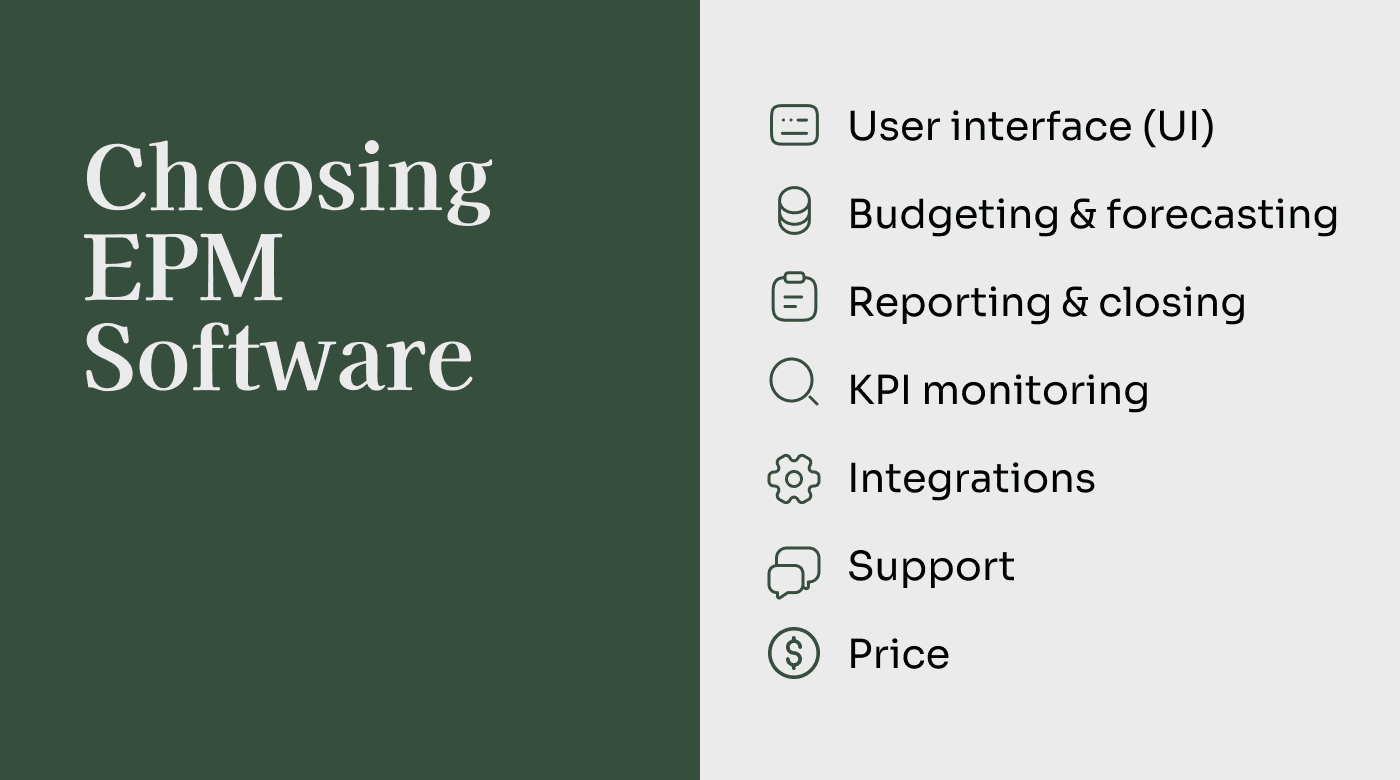
Core Functionality
At its core, EPM software should enable your organization to:
- Collect and manage data and metrics related to financial performance
- Plan, budget, and forecast future operations
- Prepare and analyze detailed financial reports and analytics
Key Features
Unique features set software solutions apart from the competition. Here are some key features I looked for in EPM software for this list:
- Data visualization: EPM software should allow you to view, manage, and analyze data in an intuitive way. All EPM solutions will provide data analysis tools, but I focused on tools that have exceptional data visualization capabilities.
- Predictive forecasting and budgeting: A core process of EPM is financial budgeting and forecasting. The best EPM platforms will have first-rate budgeting features—both enterprise-wide and on a departmental or project level—and solid forecasting and modeling tools.
- Closing and consolidation: EPM software should make your financial statement consolidation and month-end and year-end close processes more efficient. EPM systems are a vital part of both internal and external reporting.
- KPI monitoring: EPM solutions should allow for advanced key performance indicator (KPI) monitoring—both on an individual department or project level, and enterprise-wide.
Usability
Usability encompasses the user interface and user-friendliness of the software. EPM software can sometimes be complex to use, but tutorials are typically available.
Usability is particularly important if your enterprise has plans to utilize EPM software on a departmental level. Essentially, the more people that may be using the software, the more important user-friendliness becomes.
Integrations
EPM software should ideally fit in with your existing software stack.
Most ERP platforms need to pull data from accounting software, data management solutions, and HR platforms—so you’ll want to double-check to make sure that any of your existing tools or platforms in those areas will play nice with the EPM solution you’re considering.
What is EPM software?
EPM software, or Enterprise Performance Management software, is a robust solution that uses data analytics, forecast modeling, and financial planning and analysis to help firms monitor performance, model future scenarios, and plan more effectively. This software typically includes features such as budgeting and planning modules, financial reporting and analysis tools, performance dashboards, and data consolidation capabilities.
Overall, EPM software empowers organizations to adapt to dynamic business environments through improved accuracy and efficiency in financial processes, enhanced collaboration across departments, and a holistic view of performance metrics.
People Also Ask
Below you’ll find answers to some common questions about EPM software.
What is the difference between EPM vs. ERP?
EPM (enterprise performance management) focuses more on the financial aspects of an organization. It uses information from almost every aspect of a company’s operations to gather data, analyze trends, generate reports, monitor performance, and inform management in their strategic planning and goal setting efforts.
By contrast, ERP (enterprise resource planning) is much broader, and focuses on day to day business operations—supporting processes in HR, supply chain, marketing, procurement, and IT.
What are the basics of EPM?
Some of the basic functions of enterprise performance management include financial budgeting and forecasting, strategic planning, and a more efficient financial closing process (e.g. month-end or year-end close), and internal and external reporting.
EPM systems are typically in place at most large enterprises or corporations to bring together information from multiple systems so the organization can operate more efficiently.
What are the benefits of EPM software?
EPM software helps companies optimize operations, track data and analyze past performance, and make more informed business decisions. EPM tools can also benefit organizations by helping streamline certain tasks, like financial reporting and analysis, and allow managers to gain valuable insights through advanced data analytics.
A solid EPM system can help an enterprise align efforts company-wide, improving efficiency and aligning enterprise goals, reporting, and strategy across the board.
Summary
Selecting the right EPM software is an important decision, and companies should be sure to consider their existing software ecosystem when deciding which tools may be a good fit.
Ultimately, if the option you choose has the features and capabilities your team needs to succeed; whether that’s financial consolidation and closing features or KPI monitoring tools, you’ve made a great decision.
If you want more corporate finance or tech industry insights, sign up for The CFO Club's newsletter to get the latest articles, podcasts, resources, and inspiration.
















